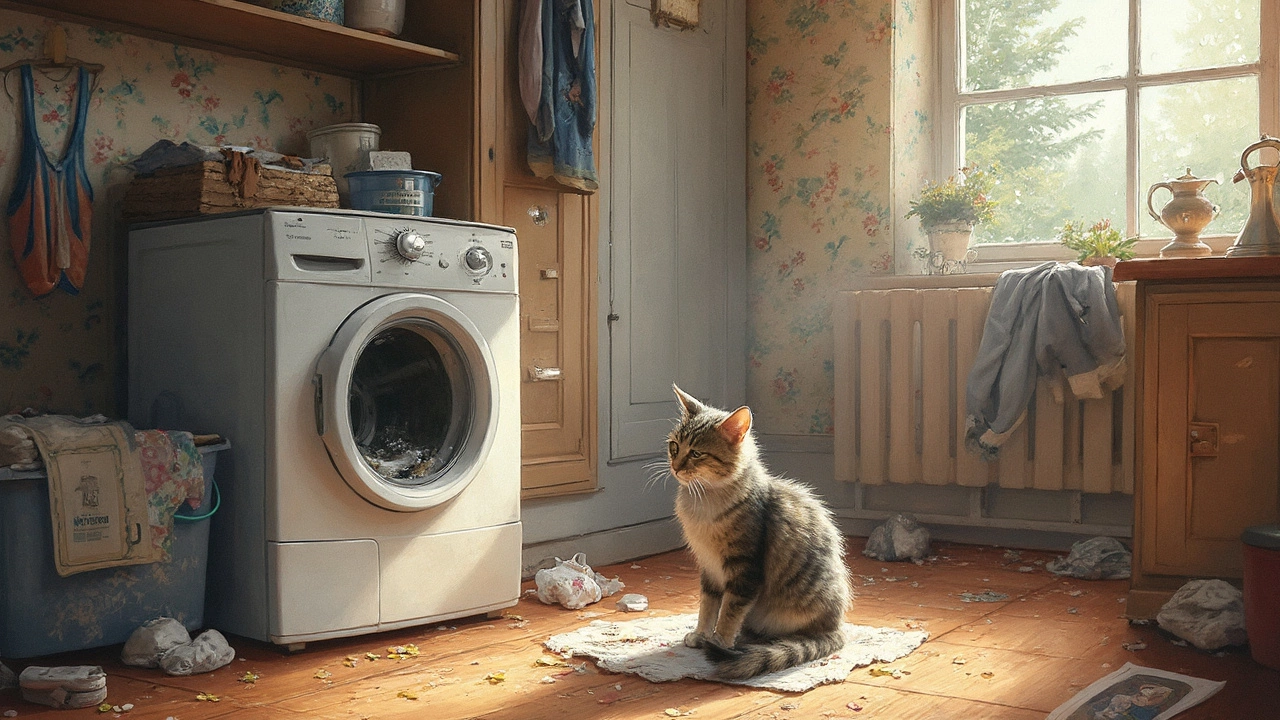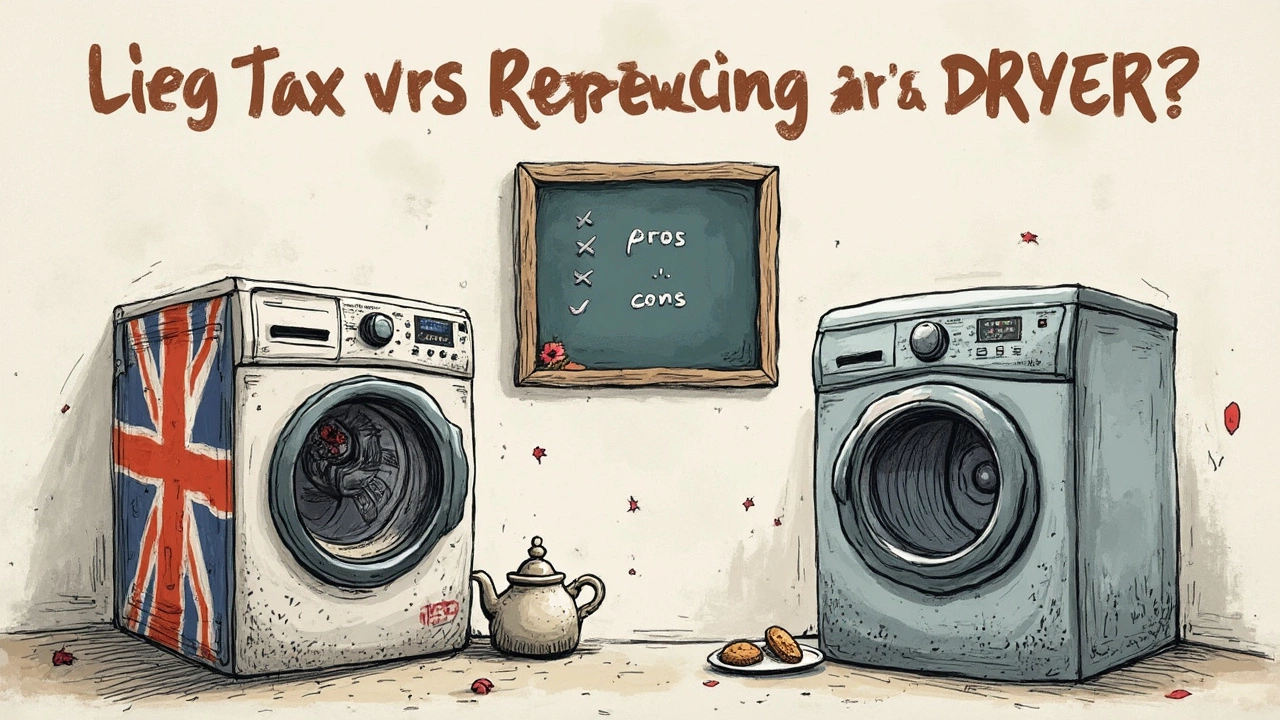
- 3 Apr 2025
- Gideon Thornton
- 0
Ever had a pile of damp laundry staring at you because your trusty dryer just wouldn't start? Frustrating, right? Here's the thing: deciding whether to repair or replace it can be a tough call. Sometimes it's not just about fixing a problem; it's about making the best choice for your wallet and your home.
First, let's talk about what's actually wrong. Is it a funny noise, a heat issue, or maybe it just won't spin? Pinpointing the exact problem is your first step to understanding what you're dealing with. Some fixes are cheap and quick—for example, replacing a broken belt or a busted fuse won't break the bank.
But let's be real. If your dryer is making sounds like a jazz band warming up, it might be a sign of bigger issues that cost more to fix—that's where your wallet might start to feel the squeeze. We’re not just talking pennies here; some complex repairs can easily rival the price of a new dryer.
- Identify the Problem
- Cost of Repairs vs. Replacement
- Age of the Dryer
- Energy Efficiency Considerations
- DIY vs. Professional Repair
- When to Call it Quits
Identify the Problem
Alright, so your dryer's on the fritz. First things first: figuring out what's gone wrong. It's like playing detective but with lint traps. There are some common dryer repair issues that most folks run into. Let’s break them down.
Start by taking a closer listen. Is your dryer making a strange noise? If you hear a thumping sound, the rollers or bearings might be worn out. A squeaking noise often points to a problem with the belt. If it's just silence, like it’s given up on life, you might be looking at an electrical issue.
Next, check if it’s doing its main job—drying. If the clothes are coming out still wet, it could be a heating element or thermostat problem. Sometimes it's as simple as a clogged vent or filter. Keep it clean to avoid these mishaps.
Another sign of trouble is the dryer taking forever to do its thing. That usually means it’s not venting properly, which can make the motor work too hard and eventually fail.
- Step 1: Listen for unusual sounds.
- Step 2: Check if the clothes are still wet.
- Step 3: Observe if drying takes too long.
- Step 4: Examine vents and filters for blockages.
Here’s a handy tip: a quick way to see if air is moving through is to look at the vent outside. If you don’t see any obvious airflow while it's running, you’ll need to clean it out.
Identifying the problem might sound complicated, but it gives you a clear path forward. You’ll know if it’s something you can tackle yourself or if it’s time to bring in a pro. In either case, understanding the issue puts you in the driver’s seat for deciding if it’s worth it to fix the dryer.
Cost of Repairs vs. Replacement
Alright, let's talk money because that's often the big deciding factor when it comes to fixing or ditching an appliance like a dryer. At the end of the day, your bank account has a vote too!
First off, let's break down the costs involved. A simple repair that tackles issues like a blown fuse or a broken belt might set you back $100 to $200. It's the kind of fix that won't burn a hole through your wallet. Quick and relatively painless.
On the flip side, if your dryer has more serious issues—like a dead motor or a faulty control board—you might be looking at repairs costing around $400 or more. By that point, it's fair to ask whether you're willing to pay a hefty chunk of change to keep an old machine running. What if I said that many new, energy-efficient dryers are priced from $500 to $800? See where I'm going with this?
A good rule of thumb is if repair costs exceed 50% of the price of a new dryer, it's likely time to start shopping around. Why? Because newer models aren't just more reliable; they often come with smart features and better energy efficiency that can save you money in the long run.
Here’s something interesting:
| Repair | Average Cost |
|---|---|
| Basic Repairs (e.g., fuse, belt) | $100-$200 |
| Major Repairs (e.g., motor, control board) | $400+ |
| New Dryer | $500-$800 |
And hey, don’t forget to factor in maintenance over time. Choosing to frequently repair an old dryer can add up, while buying a new one might mean fewer issues coming your way.
Age of the Dryer
The age of your dryer is a big factor when deciding whether to fix or toss it. Most dryers last around 10 to 13 years. If your dryer's creeping up on those numbers, it might be time to weigh your options more heavily towards replacement.
Why, you ask? Well, older dryers tend to be less energy-efficient and could end up costing you more in utility bills over time. Plus, replacement parts for older models might be harder to find, making repairs more of a hunt than a quick fix.
Here's a tip: if your trusty machine is less than five years old, it's typically worth trying to fix things first. Repairs are usually cheaper and parts are easier to get. But if it's over a decade old? That's when you might start considering a shiny new model.
Check out this quick breakdown:
| Dryer Age | Considerations |
|---|---|
| 1-5 Years | Repair it! Usually cheaper to fix, parts available. |
| 6-10 Years | Consider repair, but start watching for bigger issues. |
| 11+ Years | Think about replacement. Older models might guzzle energy. |
So, take a good look at how old your dryer is. Sometimes fixing isn’t worth it if a newer, more efficient model is just a click away. After all, you wouldn't keep pouring money into a car that's falling apart, right? Same logic applies here!

Energy Efficiency Considerations
Okay, so your dryer repair dilemma isn’t just about whether it works—it's also about how much it costs you to run. With dryer repair costs, you might also want to think about energy efficiency, because older machines can eat through electricity like nobody’s business. If you’re already shelling out cash to fix it, checking out how energy-efficient your dryer is makes a lot of sense.
Newer models are often way more efficient than the ones from a decade ago. Those energy-efficient dryers can save you a surprising amount in energy bills over time. While a typical old dryer might use about 2 to 4 kWh per load, modern ones can cut that down significantly. Besides, these newer machines often come with moisture sensors that automatically adjust drying times, saving even more energy.
If you're stuck with an older model that works like an energy hog, consider not just the immediate repair costs but also your monthly bills. You could put that electricity savings towards a newer model that does the job for less money in the long run.
Here’s a quick reality check. If your electric bill is creeping up each month, your dryer might be a culprit. A more efficient model, even if it initially costs more, might lower your bills enough to pay for itself over a few years. Here's a quick example of possible energy savings:
| Dryer Type | Average kWh per load |
|---|---|
| Old Standard Model | 3.5 |
| Energy-Efficient Model | 1.5 |
In a nutshell, when considering whether to fix your dryer, think about how much juice it’s using. Going energy-efficient isn’t just about being green; it can also mean more green staying in your pocket.
DIY vs. Professional Repair
So, your dryer's gone rogue and you're wondering if it's something you can fix yourself or if it's time to call in the big guns. Tackling a dryer repair solo can definitely save you some cash, especially if you’re handy with basic tools. But there are things to consider before you roll up your sleeves.
Pros of DIY Repair:
- Cost Savings: You won't have to pay for labor. Parts like fuses, belts, or heating elements usually aren't too pricey.
- Learning Experience: You'll get to know your appliance better, which might help with future issues.
- Convenience: No waiting around for an appointment; tackle it on your schedule.
But, and it's a big but, DIY isn’t for every situation. Some repairs need more than just a screwdriver. You might stumble if it involves electrical work or if it’s hard to diagnose the problem.
When to Go Professional:
- Complex Issues: If the motor's fried or there's an electrical fault, it's time to call a pro. Things could get dangerous, fast.
- Warranty Concerns: Messing with your dryer might void any warranty you have left. Pros will typically keep that intact.
- Time and Convenience: If you’re pressed for time or just want a guaranteed fix, a professional will get it done without the headache.
Here's a little nugget of wisdom: according to a recent survey, about 60% of homeowners who attempted appliance repair themselves ended up needing professional help anyway. While trying to fix your dryer can be empowering, remember it’s totally okay to call in experts, especially if the job's tricky.
When to Call it Quits
Alright, so your dryer's been acting up, and you've tried troubleshooting or even called in a pro, but it's just not cutting it. How do you know when enough is enough? If your dryer is pushing a decade or more, it's probably time to think about new options. Most dryers last about 10-13 years, and once they're past this age, constant repairs might just be throwing money down the drain.
Another big red flag is if repair costs are hitting you hard—like more than half the price of a new dryer hard. At this point, investing in a shiny new machine often makes more sense. With prices for new dryers usually starting at around $400-$600, it doesn’t take a genius to see where your money is better spent if repair estimates are creeping up on that number.
Beyond just age and repair costs, think about efficiency. Technology moves fast, and newer models are way more energy-efficient. They can lower your utility bills and come with fancy features that make doing laundry less of a chore. If you’ve been noticing that your energy bills are sneaking up because of your trusty old dryer, you might save in the long run by upgrading to a modern, energy-efficient model.
| Consideration | Advice |
|---|---|
| Age | 10+ years? Consider replacing. |
| Repair Costs | Over 50% of new dryer cost? Replace. |
| Energy Efficiency | High energy bills? New models save more. |
Lastly, if your dryer has become a real safety hazard—like it's catching on fire or keeps tripping the circuit breaker—it’s time to part ways for sure. Safety first, folks! We all love our clothes fresh and dry, but not at the expense of a risky appliance in our homes.




